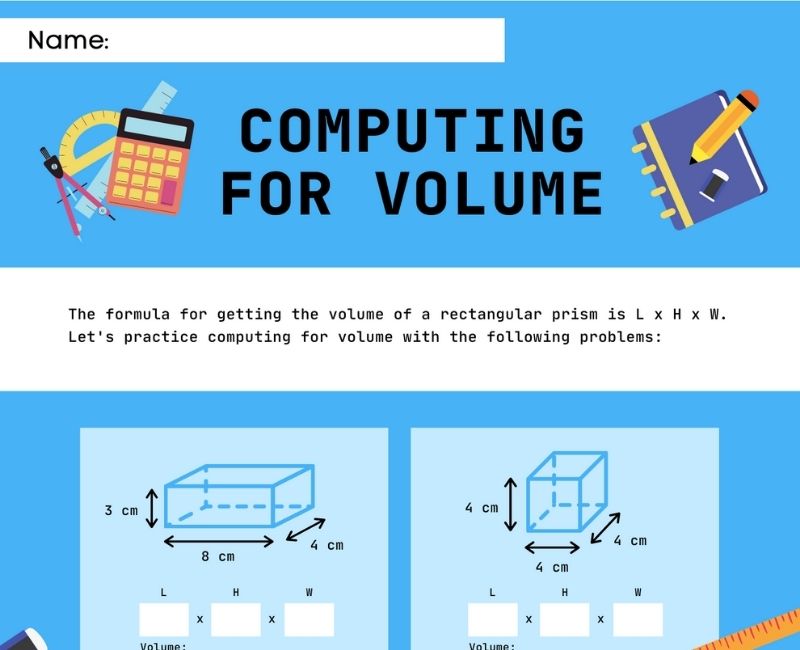Volume of Cube and Cuboid Worksheet: Practice Makes Perfect
Calculating the volume of cubes and cuboids is an important skill in math, and it's one that can be easily practiced with the help of a worksheet. This worksheet provides a variety of problems to solve, allowing you to sharpen your skills and gain confidence in your ability to calculate volume. Download it now and start practicing!
Understanding the formula for calculating volume.
Before you start practicing with this worksheet, it's important to understand the formula for calculating the volume of cubes and cuboids. The formula for calculating the volume of a cube is simply V = s^3, where s is the length of one side of the cube. For a cuboid, the formula is V = l x w x h, where l is the length, w is the width, and h is the height of the cuboid. Once you have a solid understanding of these formulas, you'll be able to tackle the problems on this worksheet with ease.
Identifying the dimensions of cubes and cuboids.
Before you can calculate the volume of a cube or cuboid, you need to identify the dimensions of the shape. For a cube, all sides are equal in length, so you only need to measure one side to find the length, width, and height. For a cuboid, you'll need to measure all three dimensions - length, width, and height - to calculate the volume. Once you have the dimensions, you can plug them into the appropriate formula to find the volume of the shape.
Applying the formula to solve problems.
Once you have identified the dimensions of the cube or cuboid, you can use the appropriate formula to calculate the volume. For a cube, the formula is simply V = s^3, where s is the length of one side. For a cuboid, the formula is V = lwh, where l is the length, w is the width, and h is the height. Practice using these formulas with the problems provided in the worksheet to improve your skills in calculating the volume of cubes and cuboids.
Differentiating between cubes and cuboids.
Before you can calculate the volume of a cube or cuboid, it’s important to be able to differentiate between the two shapes. A cube is a three-dimensional shape with six equal square faces, while a cuboid has six rectangular faces of varying sizes. By understanding the differences between these shapes, you can more easily identify the dimensions needed to calculate their volumes.
Checking answers for accuracy.
Once you have completed the volume of cube and cuboid worksheet, it’s important to check your answers for accuracy. One way to do this is to use a calculator to double-check your calculations. Another way is to compare your answers with a classmate or teacher to see if you both arrived at the same solution. By checking your answers, you can identify any areas where you may need additional practice or review.
In the realm of geometry, two fascinating three-dimensional shapes dominate elementary learning: the cube and the cuboid. A common question often arises: What is the "difference between cube and cuboid?" or, inversely, the "difference between cuboid and cube?" Essentially, a cube is a special type of cuboid, wherein all sides are equal in length, leading to six equal square faces. On the other hand, a cuboid, also known as a rectangular prism, possesses three pairs of congruent rectangular faces, where its sides may or may not be of equal length.
Understanding these shapes' dimensions is key to determining their volumes. The "volume of cube and cuboid" can be computed using distinct formulas, reflective of their individual properties. In the case of a cube, where all edges are of the same length (denoted as 'a'), the volume is given by a^3. Conversely, to "find the volume of a cuboid", one must multiply the length, width, and height (denoted as l, w, and h), resulting in the formula V = lwh. These volume computations are integral to the study of these geometric shapes and offer great insight into spatial relationships.
When we delve into "cube and cuboid examples," they're abundant in our daily life, strengthening the practical application of these concepts. Cubes are visible in dice, Rubik's cubes, or ice cubes, while cuboids are prevalent in rectangular prisms like bricks, books, or shipping boxes.
To help students practice and reinforce these concepts, the "volume of cube and cuboid worksheet" serves as a valuable resource. These worksheets provide a variety of problems, challenging learners to apply the formulas and principles they've learned. They can tackle problems like "without calculating the cubes find the value," which encourages logical thinking and problem-solving skills.
Moreover, the curriculum often expands the scope to incorporate the "volume of cube, cuboid, and cylinder." This addition provides a comparative analysis of different three-dimensional shapes, highlighting their unique properties and similarities. Understanding the distinct "volume of cube and cuboid formula" equips students with the tools to solve a broader range of geometric problems.
The "cube and cube roots class 8 worksheet with answers PDF" is an excellent resource to further enhance students' understanding. These worksheets not only cover the geometric aspects of cubes but also introduce the mathematical concept of cube roots, thereby providing a comprehensive learning experience.
In summary, the "cube cuboid shapes" are fundamental to geometric learning. Understanding the difference between a cube and a cuboid, how to calculate their volumes, and their real-world applications is crucial in math education. Through consistent practice, the use of worksheets, and exploration of practical examples, students can establish a solid foundation in understanding three-dimensional shapes and their properties. This knowledge serves as a building block for more complex mathematical and geometric concepts encountered in higher grades.






